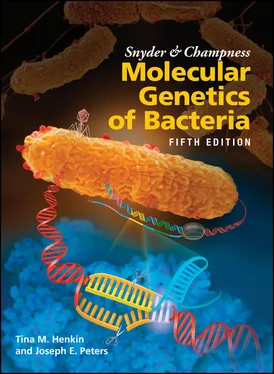Also in 1961, Francis Crick and his collaborators used phages and bacteria to show that the genetic code is unpunctuated, three lettered, and redundant. These researchers also showed that not all possible codons designate an amino acid and that some are “nonsense.” These experiments laid the groundwork for Marshall Nirenberg and his collaborators to decipher the genetic code, in which a specific three-nucleotide set encodes one of 20 amino acids. The code was later verified by the examination of specific amino acid changes due to mutations in the lysozyme gene of phage T4.
François Jacob and Jacques Monod published their operon model for the regulation of the lactose utilization genes of E. coli in 1961 as well. They proposed that a repressor blocks RNA synthesis on the lac genes unless the inducer, lactose, is bound to the repressor (see chapter 11). Their model has served to explain gene regulation in other systems, and the lac genes and regulatory system continue to be used in molecular genetic experiments, even in systems as far removed from bacteria as animal cells and viruses.
Enzymes for Molecular Biology
The early 1960s saw the start of the discovery of many interesting and useful bacterial and phage enzymes involved in DNA and RNA metabolism. In 1960, Arthur Kornberg demonstrated the synthesis of DNA in the test tube by an enzyme from E. coli . The next year, a number of groups independently demonstrated the synthesis of RNA in the test tube by RNA polymerases from bacteria. From that time on, other useful enzymes for molecular biology were isolated from bacteria and their phages, including additional RNA and DNA polymerases, polynucleotide kinase, DNA ligases, topoisomerases, and many phosphatases.
From these early observations, the knowledge and techniques of molecular genetics exploded. For example, in the early 1960s, techniques were developed for detecting the hybridization of RNA to DNA and DNA to DNA on nitrocellulose filters. These techniques were used to show that RNA is made on only one strand in specific regions of DNA, which later led to the discovery of promoters and other regulatory sequences. By the late 1960s, restriction endonucleases had been discovered in bacteria and shown to cut DNA in specific places (see Linn and Arber, Suggested Reading). By the early 1970s, these restriction endonucleases were being exploited to introduce foreign genes into E. coli (see Cohen et al., Suggested Reading), and by the late 1970s, the first human gene had been expressed in a bacterium. Also in the late 1970s, methods to sequence DNA by using enzymes from phages and bacteria were developed.
In 1988, a thermally stable DNA polymerase from a thermophilic bacterium was used to invent the technique called the polymerase chain reaction (PCR). This extremely sensitive technique allows the amplification of genes and other regions of DNA, facilitating their cloning and study. Thermally stable DNA polymerases are now an essential tool for genome sequencing.
More recently, advances in DNA synthesis and DNA recombination have been ushering in a new age of bacterial molecular genetics under the name of synthetic genomics, where massive strands of DNA large enough to comprise entire genomes can be made from the building blocks of DNA. In 2010, a significant milestone was reached with synthetic genomics when a derivative of the entire genome of Mycoplasma mycoides was synthesized from scratch, assembled by recombination, and used to replace the DNA in a related species (see Gibson et al., Suggested Reading). In one of the first demonstrations of the utility of this technique, in 2016, a minimal bacterial genome encoding only 473 genes was designed and synthesized, placing it as the smallest known genome in an autonomously replicating organism (see Hutchison et al., Suggested Reading). Amazingly and humbling, 149 of the 473 genes found necessary to support the growth of this organism are of unknown biological function, indicating that we still have much to learn about the molecular genetics of bacteria. While the ability to design bacteria de novo will likely have to include certain safeguards and greater public understanding, these types of experiments hold great promise for industrial use, as tools in medicine, and for addressing basic scientific questions, such as what is the minimum genetic requirement for life as a free-living organism.
These examples illustrate that bacteria and their phages have been central to the development of molecular genetics and recombinant DNA technology. Contrast the timing of these developments with the timing of comparable major developments in physics (early 1900s) and chemistry (1920s and 1930s), and you can see that molecular genetics is arguably the most recent major conceptual breakthrough in the history of science.
This textbook emphasizes how classical and molecular genetic approaches can be used to solve biological problems. As an educational experience, understanding the methods used and the interpretation of experiments is at least as important as the conclusions drawn. Therefore, whenever possible, the experiments that led to the conclusions are presented. The first two chapters, of necessity, review the concepts of macromolecular synthesis that are essential to understanding bacterial molecular genetics. However, they also introduce more current material, including interesting recent advances in bacterial cell biology. Chapter 1, besides reviewing the basics of DNA replication and the techniques of molecular biology, presents some recent advances in our understanding of how replication is coordinated with other cellular processes. Chapter 2, in addition to reviewing the basics of protein synthesis, presents current developments concerning protein folding, transport, and degradation. Chapter 3, similarly, reviews basic genetic principles, but with a special emphasis on bacterial genetics. Students are not likely to get some of this material in more general genetics courses, at least not in the same depth. This chapter also includes more current applications, such as gene knockouts, reverse genetics, and saturation genetics. Chapters 4through 12deal with more specific topics and the techniques that can be used to study them, with particular emphasis on recent evidence concerning the relatedness of seemingly disparate topics. The last chapter, chapter 13, focuses on how the genome is structured, the tools we use to analyze the genome, and even how to construct “new” genomes. We hope that this textbook will help put modern molecular genetics into a historical perspective, bring the reader up to date on current advances in bacterial molecular genetics, and position the reader to understand future developments in this exciting and rapidly progressing field of science.
1 Angert ER. 2012. DNA replication and genomic architecture of very large bacteria. Annu Rev Microbiol 66:197–212.
2 Avery OT, Macleod CM, McCarty M. 1944. Studies on the chemical nature of the substance inducing transformation of pneumococcal types. I. Induction of transformation by a desoxyribonucleic acid fraction isolated from pneumococcus type III. J Exp Med 79:137–158.
3 Brenner S, Jacob F, Meselson M. 1961. An unstable intermediate carrying information from genes to ribosomes for protein synthesis. Nature 190:576–581.
4 Cairns J, Stent GS, Watson JD. 1966. Phage and the Origins of Molecular Biology. Cold Spring Harbor Laboratory Press, Cold Spring Harbor, NY.
5 Cohen SN, Chang ACY, Boyer HW, Helling RB. 1973. Construction of biologically functional bacterial plasmids in vitro. Proc Natl Acad Sci USA 70:3240–3244.
Читать дальше











